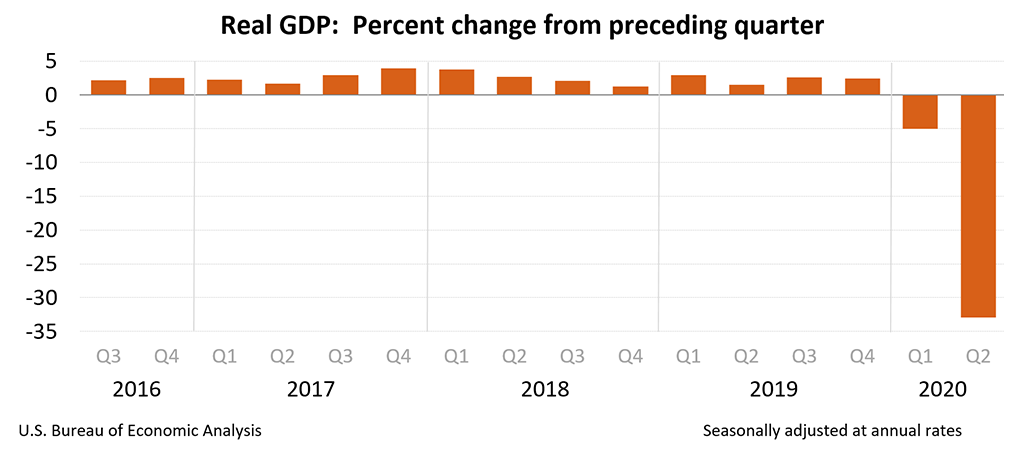Real gross domestic product (GDP) decreased at an annual rate of 32.9 percent in the second quarter of 2020 (table 1), according to the “advance” estimate released by the Bureau of Economic Analysis. In the first quarter, real GDP decreased 5.0 percent.
The GDP estimate released today is based on source data that are incomplete or subject to further revision by the source agency (see “Source Data for the Advance Estimate” on page 2). The “second” estimate for the second quarter, based on more complete data, will be released on August 27, 2020.
The decrease in real GDP reflected decreases in personal consumption expenditures (PCE), exports, private inventory investment, nonresidential fixed investment, residential fixed investment, and state and local government spending that were partly offset by an increase in federal government spending. Imports, which are a subtraction in the calculation of GDP, decreased (table 2).
The decrease in PCE reflected decreases in services (led by health care) and goods (led by clothing and footwear). The decrease in exports primarily reflected a decrease in goods (led by capital goods). The decrease in private inventory investment primarily reflected a decrease in retail (led by motor vehicle dealers). The decrease in nonresidential fixed investment primarily reflected a decrease in equipment (led by transportation equipment), while the decrease in residential investment primarily reflected a decrease in new single-family housing.
Current‑dollar GDP decreased 34.3 percent, or $2.15 trillion, in the second quarter to a level of $19.41 trillion. In the first quarter, GDP decreased 3.4 percent, or $186.3 billion (table 1 and table 3).
The price index for gross domestic purchases decreased 1.5 percent in the second quarter, in contrast to an increase of 1.4 percent in the first quarter (table 4). The PCE price index decreased 1.9 percent, in contrast to an increase of 1.3 percent. Excluding food and energy prices, the PCE price index decreased 1.1 percent, in contrast to an increase of 1.6 percent.
Personal Income and Outlays
Current-dollar personal income increased $1.39 trillion in the second quarter, compared with an increase of $193.4 billion in the first quarter. The increase in personal income was more than accounted for by an increase in personal current transfer receipts (notably, government social benefits) that was partly offset by declines in compensation and proprietors’ income (table 8). Additional information on several factors impacting personal income can be found in “Effects of Selected Federal Pandemic Response Programs on Personal Income.”
Disposable personal income increased $1.53 trillion, or 42.1 percent, in the second quarter, compared with an increase of $157.8 billion, or 3.9 percent, in the first quarter. Real disposable personal income increased 44.9 percent, compared with an increase of 2.6 percent.
Personal outlays decreased $1.57 trillion, after decreasing $232.5 billion. The decrease in outlays was led by a decrease in PCE for services.
Personal saving was $4.69 trillion in the second quarter, compared with $1.59 trillion in the first quarter. The personal saving rate—personal saving as a percentage of disposable personal income—was 25.7 percent in the second quarter, compared with 9.5 percent in the first quarter.
Source Data for the Advance Estimate
Information on the source data and key assumptions used in the advance estimate is provided in a Technical Note that is posted with the news release on BEA’s Web site. A detailed “Key Source Data and Assumptions” file is also posted for each release. For information on updates to GDP, see the “Additional Information” section that follows.
Annual Update of the National Income and Product Accounts
The estimates released today also reflect the results of the Annual Update of the National Income and Product Accounts (NIPAs). The timespan of the update is the first quarter of 2015 through the fourth quarter of 2019 for estimates of real GDP and its major components, and the first quarter of 1999 through the fourth quarter of 2019 for estimates of income and saving. The reference year remains 2012. More information on the 2020 Annual Update is included in the May Survey of Current Business article, “GDP and the Economy.”
For the period of expansion from the second quarter of 2009 through the fourth quarter of 2019, real GDP increased at an annual rate of 2.3 percent, the same as previously published.
With today’s release, most NIPA tables are available through BEA’s Interactive Data application on the BEA Web site (www.bea.gov). See “Information on Updates to the National Income and Product Accounts” for the complete table release schedule and a summary of results, which includes a discussion of methodology changes. A table showing the major current‑dollar revisions and their sources for each component of GDP, national income, and personal income is also provided. The August 2020 Survey of Current Business will contain an article describing the update in more detail.
Previously published estimates, which are superseded by today’s release, are found in BEA’s archives.
Updates for the First Quarter of 2020
For the first quarter of 2020, real GDP is estimated to have decreased 5.0 percent (table 1), the same decrease as previously published. An upward revision to private inventory investment was offset by a downward revision to exports and an upward revision to imports.
Real GDI is now estimated to have decreased 2.5 percent in the first quarter (table 1); in the previously published estimates, first-quarter GDI was estimated to have decreased 4.4 percent. The leading contributor to the upward revision was compensation, based primarily on new first-quarter wage and salary estimates from the BLS Quarterly Census of Employment and Wages.
The price index for gross domestic purchases is now estimated to have increased 1.4 percent in the first quarter, 0.3 percentage point lower than previously published (table 4). The PCE price index increased 1.3 percent, the same increase as previously published. Excluding food and energy prices, the PCE price index increased 1.6 percent, 0.1 percentage point lower than previously published.



















